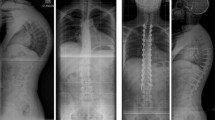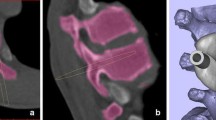Abstract
Purpose
Severe spinal deformity is a complex morphological deformation that occurs and develops in three-dimensional space combined with abnormal development and morphology of anatomical structures, which presents great difficulties in the process of transpedicular screw placement. This study tried to explore the methods of transpedicular screw placement in surgical correction of severe spinal deformities.
Methods
Surgical corrections through posterior approach were performed in all the 76 cases (mean age 20.4 years). The averaging preoperative Cobb’s angle of scoliosis was 108.2° ± 33.6° (range 100°–170°). Among these patients, 34 cases were combined with kyphosis; the average Cobb’s angle of kyphosis was 77.3° (range 63°–160°). During operation, the screw tract was first established with the regular free-hand pedicle screw placement method. When this failed, in order to adjust the screw trajectory, a five-step remedial method was performed in the following order: (1) the“funnel” method; (2) exploring the pedicle exterior edge through the costotransverse joint; (3) exploring the superior and inferior edges of pedicle through the nerve root canal; (4) the vertebral plate fenestration; and (5) hemilaminectomy.
Results
Among all 1,472 screws planned to be placed for the patients, 1,210 (82.2 %) were successfully placed after using the regular method, and 262 (17.8 %) failed in this stage. After applying the five-step remedial method, 256 of the failed 262 screws were successfully placed. Among them, 176 screws (68.8 %) were successfully placed after Step 1, 44 (17.2 %) after Step 2, 21 (8.2 %) after Step 3, 12 (4.7 %) after Step 4, and 3 (1.2 %) after Step 5. In only six, pedicles screws could not be placed eventually. No nerve or blood vessel damages occurred in all cases. All final screw positions were validated by CT.
Conclusion
The five-step remedial method proved to be an effective supplementary method for transpedicular screw placement to treat patients with severe spinal deformities. The key points include a detailed preoperative plan, a meticulous hand drilling sensation, and an experienced probing technique for screw tract.



Similar content being viewed by others
References
Kim YJ, Lenke LG, Bridwell KH et al (2004) Free hand pedicle screw placement in the thoracic spine: is it safe? Spine 29:333–342
Senaran H, Shah SA, Gabos PG et al (2008) Difficult Thoracic Pedicle Screw Placement in Adolescent Idiopathic Scoliosis. J Spinal Disord Tech 21:187–191
Lehman RA, Lenke LG, Keeler KA et al (2008) Operative treatment of adolescent idiopathic scoliosis with posterior pedicle screw-only constructs minimum three-year follow-up of one hundred fourteen cases. Spine 33:1598–1604
Kim YJ, Lenke LG, Cho SK et al (2004) Comparative analysis of pedicle screw versus hook instrumentation in posterior spinal fusion of adolescent idiopathic scoliosis. Spine 29:2040–2048
Lee CS, Kim MJ, Ahn YJ et al (2007) Thoracic pedicle screw insertion in scoliosis using posteroanterior C-arm rotation method. J Spinal Disord Tech 20:66–71
Zindrick MR, Knight GW, Sartori MJ et al (2000) Pedicle morphology of the immature thoracolumbar spine. Spine 25:2726–2735
Suk SI, Kim WJ, Lee SM et al (2001) Thoracic pedicle screw in spinal deformities: are they really safe. Spine 26:2049–2057
Parent S, Labelle H, Skalli W et al (2004) Thoracic pedicle morphometry in vertebrae from scoliotic spines. Spine 29:239–248
Xie JM, Wang YS, Zhang Y et al (2007) Operative skill of lower cervical transpedicle screw. Orthop J China 15:745–748
Yossi S, Michael AM, Yoram A et al (2005) Accuracy and safety of thoracic pedicle screw placement in spinal deformities. J Spinal Disord Tech 18:522–526
Feyza KG, Erhan EM, Hakan S et al (2006) Accuracy of pedicle screw placement for upper and middle thoracic pathologies without coronal plane spinal deformity using conventional methods. J Spinal Disord Tech 19:436–441
Girardi FR, Cammisa FP Jr, Sandhu HS et al (1999) The placement of lumbar pedicle screws using computerized stereotactic guidance. J Bone Joint Surg Br 81:825–829
Lenke LG, Watanabe K (2006) When to avoid pedicle screw fixation (abstract). In: The 41st Annual Meeting of the Scoliosis Research Society Pre-Course, Monterey, CA, 13 Sept 2006
Watanabe K, Lenke LG, Matsumoto M et al (2010) A novel pedicle channel classification describing osseous anatomy: how many thoracic scoliotic pedicles have cancellous channels? Spine 35:1836–1842
Klane KW, Richard O, Andrew TM et al (2006) Pullout strength of thoracic pedicle screw instrumentation: comparison of the transpedicular and extrapedicular techniques. Spine 31:355–358
Xie JM, Wang YS, Zhao Z et al (2011) The safe placement of upper and middle thoracic pedicle screws in pediatric deformity. J Spinal Disord Tech 24(1):55–59
Liljenqvist UR, Allkemper T, Hackenberg L et al (2002) Analysis of vertebral morphology in idiopathic scoliosis with use of magnetic resonance imaging and multiplanar reconstruction. J Bone Joint Surg Am 84-A:359–368
Vaccaro AR, Rizzolo SJ, Balderston RA et al (1995) Placement of pedicle screws in the thoracic spine. Part II: an anatomical and radiographic assessment. J Bone Joint Surg Am 77:1200–1206
Conflict of interest
The authors did not receive grants or outside funding in support of their research for or preparation of this manuscript. They did not receive payments or other benefits or a commitment or agreement to provide such benefits from a commercial entity. No commercial entity paid or directed, or agreed to pay or direct, any benefits to any research fund, foundation, education institution, or other charitable or nonprofit organization with which the author are affiliated or associated.
Author information
Authors and Affiliations
Corresponding author
Rights and permissions
About this article
Cite this article
Xie, JM., Zhao, Z., Yang, H. et al. A five-step remedial screw placement method to treat severe spinal deformity with free-hand transpedicular screw placement. Eur Spine J 22, 417–424 (2013). https://doi.org/10.1007/s00586-012-2546-y
Received:
Revised:
Accepted:
Published:
Issue Date:
DOI: https://doi.org/10.1007/s00586-012-2546-y




